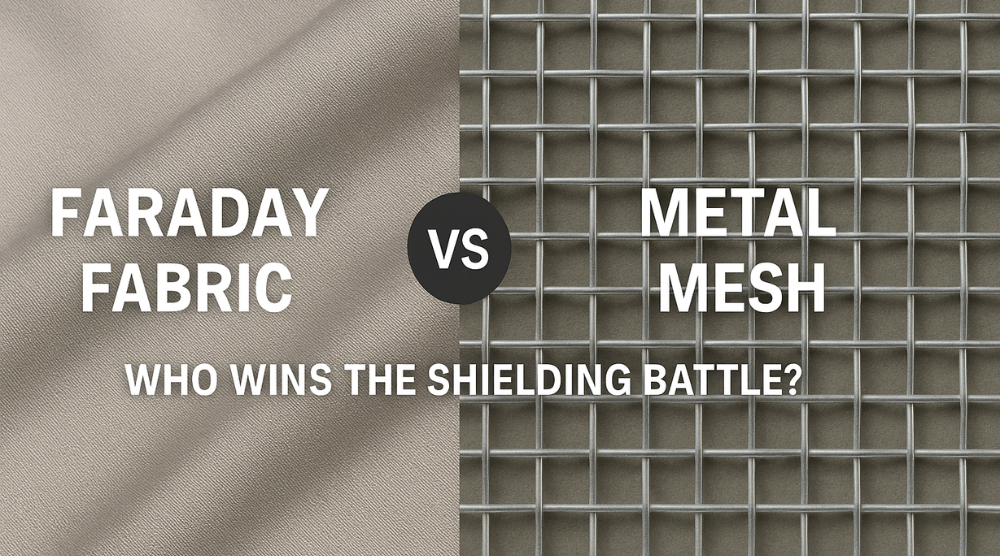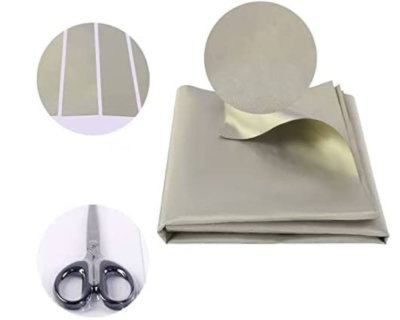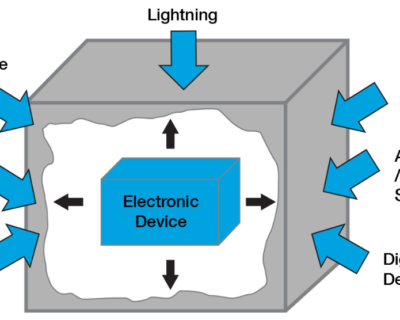Blogs

Faraday Fabric vs Metal Mesh: Which Offers Better EMF Protection? | DOMADIA™
The Invisible Battle for Your Privacy
Imagine working late on your laptop when you notice your Wi-Fi slowing down, Bluetooth devices glitching, or your smart assistant lighting up for no reason. You brush it off. But what if invisible electromagnetic interference (EMI) was quietly disrupting your electronics — and maybe even your peace of mind?
That’s where shielding materials step in. But which one actually works better — Faraday Fabric or Metal Mesh? Both are designed to block EMFs (Electromagnetic Fields), but their performance, usability, and efficiency can differ dramatically depending on your needs.
Let’s decode the science — and help you pick the right shield.
What is EMF Protection and Why It Matters
EMFs (Electromagnetic Fields) are emitted by everything — from your Wi-Fi router and mobile tower to the wiring in your walls. While these signals make wireless communication possible, they can also cause signal interference, data leaks, or even sleep disturbances in sensitive individuals.
To block them, we rely on materials that reflect or absorb electromagnetic energy — creating what’s known as a Faraday Cage Effect. Both Faraday Fabric and Metal Mesh achieve this effect, but in very different ways.
What Is Faraday Fabric?
Faraday Fabric, offered by DOMADIA™, is a flexible, conductive textile woven with metal fibers such as nickel, copper, or silver. It works like a soft, portable shield that can block radiofrequency (RF) and electromagnetic interference across a wide frequency range.
Chemical Composition:
Typically made of:
- 20–40% nickel or silver coated on nylon/polyester threads
- Copper or stainless-steel microfibers for conductivity
- Protective polymer base for flexibility and durability
Properties:
- Highly Conductive: Surface resistance as low as 0.05 Ω/sq
- Lightweight & Breathable: Easy to use for clothing, curtains, or wall linings
- Corrosion Resistant: Especially in silver- or nickel-coated variants
Broad Spectrum Shielding: Up to 99.9% attenuation (40–70 dB) from 10 MHz to 40 GHz
Applications:
- Shielding rooms or offices from 5G/Wi-Fi radiation
- EMI-protected enclosures for testing electronics
- Anti-tracking pouches for phones, key fobs, and RFID cards
- Wearable EMF protection clothing
What Is Metal Mesh?
Metal Mesh (usually copper, aluminum, or stainless steel) is a rigid or semi-flexible grid that conducts electricity and deflects electromagnetic waves. It’s the traditional choice for industrial and defense-level shielding — think server rooms, signal test chambers, and grounded enclosures.
Chemical Composition:
- 100% metallic structure — often copper, brass, or stainless steel
- May include galvanized or coated layers for corrosion protection
Properties:
- High Conductivity: Excellent reflection of low-frequency EMFs
- Strong & Durable: Long lifespan, suitable for permanent installations
- Corrosion Resistance: Moderate to high, depending on material
- Shielding Effectiveness: Up to 80–100 dB in tightly woven meshes
Applications:
- Server rooms & data centers (RF shielded walls)
- Military and defense enclosures
- Industrial equipment shielding
- Grounded testing facilities
Faraday Fabric vs Metal Mesh: The Key Differences
| Feature | Faraday Fabric (DOMADIA™) | Metal Mesh |
| Flexibility | Soft, foldable, easy to install anywhere | Rigid or semi-flexible |
| Weight | Lightweight | Heavy |
| Shielding Range | Broad-spectrum (RF, Wi-Fi, 5G, Bluetooth) | Excellent at low-frequency shielding |
| Ease of Use | DIY-friendly, sewable, portable | Needs professional installation |
| Aesthetic Appeal | Can blend into decor (as curtains or wallpaper) | Industrial look |
| Cost | Cost-effective for small areas | Costly for large setups |
| Environmental Impact | Reusable, less metal usage | Requires more metal, harder to recycle |
| Applications | Home, healthcare, and electronics | Industrial and defense sectors |
Environmental Impact: The Green Advantage
Unlike rigid meshes that require significant metal mining and manufacturing, Faraday Fabric from DOMADIA™ uses thin metal coatings — drastically reducing environmental impact.
Its longer lifespan, lower weight, and reusability make it the eco-friendlier choice. Plus, fewer replacements mean less waste and less recycling energy consumed — a quiet yet powerful contribution to sustainability.
Standards and Testing
- ASTM D4935-18: Standard for shielding effectiveness testing
- MIL-STD-285: Military-grade RF attenuation benchmark
- IEEE 299: Measurement of electromagnetic shielding for enclosures
DOMADIA™ Faraday Fabric meets or exceeds these standards, making it reliable for both industrial and personal EMF protection applications.
Final Verdict: The Better Shield
If you need flexibility, DIY usability, and modern aesthetics, Faraday Fabric by DOMADIA™ is your winner.
If you’re shielding an industrial or defense-level installation that demands rigid structures, metal mesh still holds its ground.
But for the modern world — from EMF-safe homes to secure corporate environments — Faraday Fabric offers the perfect balance of performance, portability, and sustainability.
Takeaway
When it comes to EMF protection, it’s not just about blocking signals — it’s about doing it smartly and sustainably.
And that’s where DOMADIA™ Faraday Fabric shines: effective, eco-conscious, and elegantly engineered for modern living.
Choose smarter shielding. Experience the flexibility and performance of DOMADIA™ Faraday Fabric — engineered for modern EMF protection.
Explore Now on DOMADIA.net.
Follow us on LinkedIn: https://www.linkedin.com/in/kairav
Talk to: Er.Pankaj Domadia | Kairav Domadia | Aadil Domadia | Pragati Sanap | Pooja N N
#FaradayFabric #EMFProtection #MetalMesh #EMIShielding #DOMADIA #SustainableLiving #TechSafety #5GShielding #RFProtection




